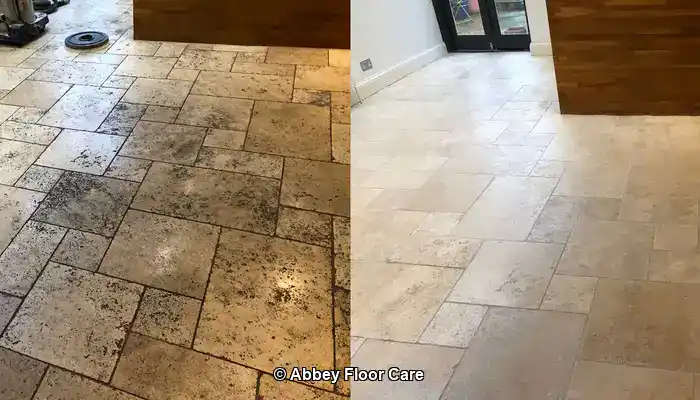
How To Get Dirty Tumbled Travertine Clean Again
Last Updated on September 27, 2025 by David
Are your dirty, tumbled travertine tiles keeping you up at night?
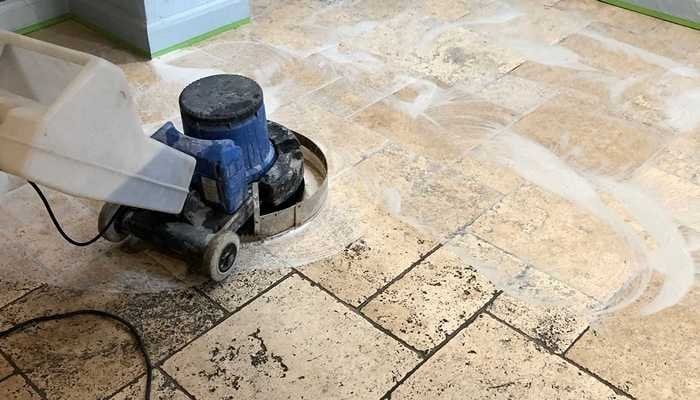
We have had numerous customers who were ready to tear up their tumbled travertine flooring because they could not get it clean.
It is a story we often hear about how the tiles looked beautiful in the store and even better when they were laid, justifying the significant cost of the flooring. However, after just a short time, the floor started to get dirty and soon became impossible to clean.
Jump Straight To The Section You Need
How To Deep Clean Travertine Floors
; Regular Maintenance Tips
7 Expert Tips To Keep Your Travertine Clean
Some Products To Help Make Cleaning So Much Easier.
How To Deep Clean Travertine Floors
The honeycomb structure of Travertine and the nature of the grout lines mean that your Travertine floor will likely require deep cleaning every year or every other year. Deep cleaning will also help to remove staining from the tiles and grout lines.
Travertine cleaning is a task a homeowner can undertake with the right materials and equipment.
Equipment:
We recommend these products for deep cleaning and daily maintenance.

Wet & Dry Vacuum Cleaner
|

Spin Mop System
|

Deck Scrubber Brush
|

Hand Scrub Brush
|

Grout Scrub Brush
|

LTP Grimex Alkaline Cleaner
|
Deep Cleaning Travertine Tiles
Carefully vacuum the floor to remove all dry soil, loose dirt, and grit. Please don’t skip this step, as mixing the soil and grit with the cleaner can result in a cutting paste. Make up a bucket of cleaning solution using the strong cleaner and warm water according to the manufacturer’s instructions. If your floor has a worn topical sealer, you may need to remove the old sealer with a sealer-removing cleaner. The sealer remover will also act as a strong floor cleaner. Clean and manageable areas, with floor spaces ranging from four to eight square metres.
Mopping Travertine Tiles
Spread the dilute cleaner over a manageable area of the floor using the mop, mop well into the surface of the tiles and the grout. Leave the cleaner to work for 5 to 10 minutes. During this time, keep the floor wet; do not let it dry out.
Scrubbing Travertine Tiles
Scrub the floor with the deck brush and hand brush, ensuring that you work the cleaner into the tile’s holes and grout lines to remove any dirt buildup. Removing the dirty water and slurry with the mop or a wet vacuum will be much easier.
Rinsing Travertine Tiles
Rinse the area with clean warm water. Once the rinse water gets dirty, replace it with clean, fresh water. To dry the floor quickly, use a clean, dry towel or a soft, absorbent cloth to wipe it off gently.
Treating Grout Stains On Travertine
If you have deep staining in the grout lines, you may need to use a small amount of acid grout cleaner.
Be careful not to get the grout cleaner on the tiles, because the acid will damage the surface of your travertine.
Repeat the travertine cleaning process until the floor is as clean as possible. Then move onto the next area of the floor.
Resealing Your Travertine Floor
After you’ve deep-cleaned your floor and are satisfied with its appearance, the next step is to reapply the sealer. You can choose from a few types of sealers:
- Impregnating sealers, which soak into the stone to protect it from within
- Topical sealers, which create a protective layer on the surface
- Or a combination of an impregnating sealer followed by a wax coating for extra shine
Pro Tip: We recommend these products for sealing your Tumbled Travertine.

LTP MPG Sealer H20
|
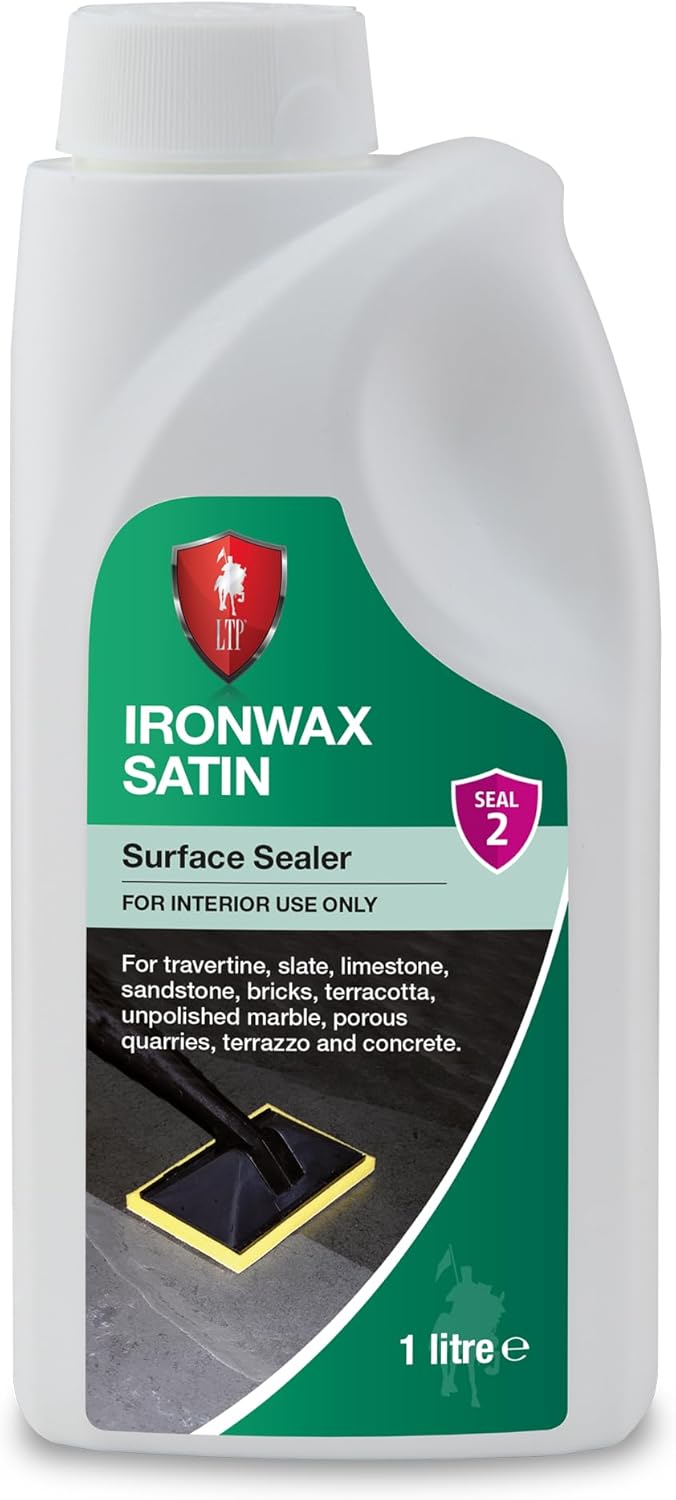
LTP Ironwax Satin
|

LTP Clear Wax
|

LTP Sealer Pack
|
Wax coatings look beautiful but require a lot of care and regular maintenance. Applying wax is usually a hands-and-knees job, involving lots of hand buffing—unless you have a floor buffer machine. Because of this, we typically recommend either an impregnating or topical sealer, as they’re much easier to maintain and keep your floor protected.
Regardless of the sealing method you choose, ensure that you follow the manufacturer’s instructions closely. Pay special attention to drying times between each coat and any recommended tests; this helps ensure the sealer provides full protection for your floor.
Regular Maintenance – How To Clean Travertine Floors
Regular travertine cleaning differs from deep cleaning in the cleaning chemicals and equipment used.
Equipment for Regular Cleaning
- Dry Vacuum or Microfiber Dry Mop
- For regular mopping, use a microfiber Mop
- Ph Neutral Travertine Cleaner for a floor with an Impregnating sealer
- A cleaner containing a small amount of polishing product for a Topical Sealer
- A pH-neutral cleaner with a small amount of stone soap or linseed oil for a Wax finish
Cleaning Products

Fila Pro Floor Cleaner
Floors Sealed with an Impregnating Sealer
|

LTP Floorshine
Floors sealed with a Topical sealer
|

LTP Wax Wash
Floors with a wax coating
|
How To Clean Travertine Tile And Grout
Carefully vacuum the floor to remove all loose dirt particles and grit. Please don’t skip this step, as mixing the soil and grit with the cleaner can result in a cutting paste.
Prepare a solution of the desired Travertine cleaner and warm water, according to the manufacturer’s instructions.
Mop the cleaner onto the floor with a damp mop and remove as much cleaning slurry as possible.
Allow the floor to dry. If you notice any areas where the protection is degrading, top up the protection in that area.
7 Expert Tips To Keep Your Travertine Clean
If you’re looking for help with cleaning travertine tiles, these expert tips will help you keep your Travertine floors clean.
1. Know Your Stone
One of the most essential tips to help you keep your Travertine floor looking like new is to educate yourself about its characteristics. Here are some key attributes of Travertine tile products that you should be aware of.
- Travertine has a honeycomb structure; new holes can appear at any time.
- Unfilled tumbled travertine has holes that will fill with dirt over time.
- Honed and Filled Travertine will crack more easily than a homogeneous stone, such as marble.
- Travertine can suffer permanent damage from Acid and harsh chemicals because it is a type of Limestone, formed from calcium.
- Travertine can be matt, honed or polished.
- Travertine can be sealed with Impregnating sealers, Topical sealers and wax.
2. Choose The Right Stone Cleaner
Before cleaning your Travertine floor tiles, ensure you have the correct cleaner for the job. Different stones need different cleaning products. A cleaner that will work well on a slate floor could cause irreversible damage to a Travertine floor. Once you know that Travertine is formed from calcium, you can choose the right cleaner for the cleaning you are doing. When deep cleaning travertine, you can use a strong alkali cleaner; however, be sure to rinse the floor thoroughly to remove all traces of the cleaner. If you are undertaking regular maintenance cleaning, then use a pH-neutral cleaner, preferably containing a small amount of stone soap or linseed oil. If you need a stronger cleaner for stubborn or ingrained dirt, then choose the right cleaning product for the stone. Also, make sure to rinse the floor with clean water after using a strong cleaner. Don’t use Acid cleaners on Travertine, because the acid will dissolve the surface, leaving dull, ugly etch marks. With this information, you will be able to clean your Travertine without causing damage.
3. Dry Sweep or Vacuum the Travertine
 Over 80% of the soil in a home is dry soil, containing dust, dander, grit, and other particles. Dirt will damage your stone and the sealer. And polished floors, in particular, suffer from scratching. The best way to prevent damage from dry soil is to dry-sweep your floor at least once a day. If you have pets and or small children, then you may need to dry mop two or three times a day. Modern microfiber sweeping mops are low-cost, lightweight and easy to use.
Over 80% of the soil in a home is dry soil, containing dust, dander, grit, and other particles. Dirt will damage your stone and the sealer. And polished floors, in particular, suffer from scratching. The best way to prevent damage from dry soil is to dry-sweep your floor at least once a day. If you have pets and or small children, then you may need to dry mop two or three times a day. Modern microfiber sweeping mops are low-cost, lightweight and easy to use.
4. Use A Microfiber Damp Mop
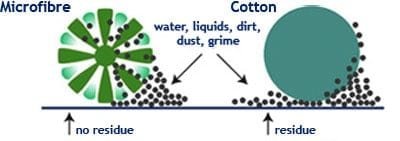 With modern microfiber mops, there is no need to use a mop and bucket on your stone floors. Old-style cotton mops are unhygienic and inefficient. They leave most of the soil on the surface of the floor. They are one of the leading causes of dirty grout lines. Microfiber mops work differently from cotton mops. They pick the damp soil from the stone and trap it in the fibres. Dirty mop heads are machine-washed, rather than squeezed, making them much more hygienic. Microfiber mops are available online, in most supermarkets and DIY outlets.
With modern microfiber mops, there is no need to use a mop and bucket on your stone floors. Old-style cotton mops are unhygienic and inefficient. They leave most of the soil on the surface of the floor. They are one of the leading causes of dirty grout lines. Microfiber mops work differently from cotton mops. They pick the damp soil from the stone and trap it in the fibres. Dirty mop heads are machine-washed, rather than squeezed, making them much more hygienic. Microfiber mops are available online, in most supermarkets and DIY outlets.
5. Protect Your Travertine With A Travertine Sealer
“Do we need to seal our travertine?” is one of the most frequently asked questions we receive. We answer that sealing is essential for all forms of Travertine. Modern stone sealers can be grouped into three broad types.
Topical Sealers
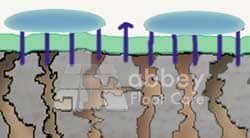 Topical Sealers sit on the surface of the travertine. They will change the finish on the tiles, giving dull tiles a sheen or a gloss finish. They can alter the slip resistance, especially when the surface is wet. Being on the surface of the stone, they will eventually show wear, particularly in high-traffic areas.
Topical Sealers sit on the surface of the travertine. They will change the finish on the tiles, giving dull tiles a sheen or a gloss finish. They can alter the slip resistance, especially when the surface is wet. Being on the surface of the stone, they will eventually show wear, particularly in high-traffic areas.
Impregnating Sealers
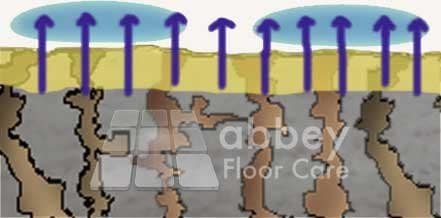
Impregnating or penetrating sealers penetrate deep into the surface of the travertine through the capillaries. They change the surface tension of the stone, repelling water and oil spills. With this kind of sealer, the stone acts as the wear layer. Manufacturers often claim a lifespan of 10 to 15 years. This may be true for the sealer that has soaked deeply into the stone, but the areas of sealer near the surface will be degraded by traffic and chemical attack. That is why they should be topped up annually, to maintain the levels of protection. Thankfully, applying the sealer is a simple task of using it with a cloth and then wiping away any surface residue. So it is an easy job.
Waxing
Wax is the original sealer. Modern waxes provide a hard-wearing finish that is easy to maintain. Modern Impregnating and Topical sealers are the more popular finishes, but a Wax finish will give you years of life if maintained properly.
6. Prevent Soil Coming Onto The Floor And Other Forms Of Damage
- Use rugs and mats at every entrance to trap most of the sand and stop the grit from getting into your floor.
- Don’t walk over Travertine with outdoor shoes.
- Use furniture protectors on chair and table legs; chair legs can be very abrasive.
- Wipe up spills immediately to prevent them from turning into stains.
7. Seek The Advice Of Travertine Cleaning Experts
 Over time, a polished finish will dull, the sealer will wear, the grout will start to become dirty, and the soil will become ingrained. You should not leave it that long. As soon as your floor is laid, it is advisable to contact a stone restoration company. Travertine cleaning experts can give you valuable ongoing advice.
Over time, a polished finish will dull, the sealer will wear, the grout will start to become dirty, and the soil will become ingrained. You should not leave it that long. As soon as your floor is laid, it is advisable to contact a stone restoration company. Travertine cleaning experts can give you valuable ongoing advice.
In many ways, a stone floor is like a car; regular servicing will keep it in tip-top condition, and it will last longer. People service their cars according to the manufacturer’s schedule. But they never think of servicing their stone floors.
A polished Travertine floor does not need to be completely dull before it is re-polished.
A Travertine sealer does not need to be worn entirely away before being resealed.
Your floor will last longer, and you will save money if you schedule a visit with a local stone floor restoration company.
Interim deep cleaning and polishing or sealing will make the finish last much longer. It is also less expensive and less disruptive than a complete restoration.
Your restoration expert will provide guidance on post-restoration cleaning. They can also keep you up to date with the latest money-saving developments. For helpful advice on your stone floor, please don’t hesitate to contact us. We are more than happy to help.
Some Products To Help Make Cleaning So Much Easier.
As an Amazon Associate I earn from qualifying purchases.
Flash Duster Dust Magnet Refills, Trap & Lock Away Dust, Dirt, Hair & Allergens In No Time, 25 Dusters (5x5) £14.90 (as of October 13, 2025 07:01 GMT +00:00 - More infoProduct prices and availability are accurate as of the date/time indicated and are subject to change. Any price and availability information displayed on [relevant Amazon Site(s), as applicable] at the time of purchase will apply to the purchase of this product.)
Elbow Grease Rubber Gloves | Cotton Lined, Super Strong, Non-Slip Household Cleaning Gloves (Medium) £1.29 (as of October 13, 2025 07:01 GMT +00:00 - More infoProduct prices and availability are accurate as of the date/time indicated and are subject to change. Any price and availability information displayed on [relevant Amazon Site(s), as applicable] at the time of purchase will apply to the purchase of this product.)
Cotton Floor Mop System With Super Absorbent Head, 110cm Metal Handle and Extra Refill - Effective Cleaning For Home, Office and Commercial Use £9.99 (as of October 13, 2025 07:01 GMT +00:00 - More infoProduct prices and availability are accurate as of the date/time indicated and are subject to change. Any price and availability information displayed on [relevant Amazon Site(s), as applicable] at the time of purchase will apply to the purchase of this product.)
Flash Speedmop Floor Cleaner Starter Kit, Fast Easy and Hygienic (1 Handle, 8 Wet plus 16 Dry Refills), Trap and Lock Daily Dirt, Grease and Grime Without Getting Down On Your Knees £21.49 (as of October 13, 2025 07:01 GMT +00:00 - More infoProduct prices and availability are accurate as of the date/time indicated and are subject to change. Any price and availability information displayed on [relevant Amazon Site(s), as applicable] at the time of purchase will apply to the purchase of this product.)
LANON 3 Pairs wahoo Skin-Friendly Dishwashing Cleaning Gloves, Latex Free Unlined Kitchen Gloves, Reusable, Non-Slip, Icelandic Blue, Small £13.99 (as of October 13, 2025 07:01 GMT +00:00 - More infoProduct prices and availability are accurate as of the date/time indicated and are subject to change. Any price and availability information displayed on [relevant Amazon Site(s), as applicable] at the time of purchase will apply to the purchase of this product.)
Recent Posts:
We work throughout the country, just some of our work counties:
Copyright © Fabritec - Abbey Floor Care. Natural Stone Floor Restoration in Surrey and South West London FAQ - Privacy Policy - Terms And Conditions




